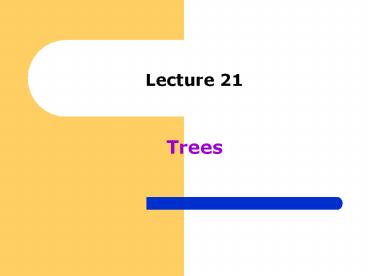Trees - PowerPoint PPT Presentation
Title:
Trees
Description:
DOM trees (browsers) cider. like. red. I. apple. and. wine. A tree is a set of nodes and a set of directed edges that connects pairs of nodes. ... – PowerPoint PPT presentation
Number of Views:23
Avg rating:3.0/5.0
Title: Trees
1
Lecture 21
- Trees
2
Trees
- A useful data structure for many applications
3
Applications
- Compiler design
- text processing (dictionary)
- searching algorithms
- DOM trees (browsers)
cider
like
red
I
apple
and
wine
4
Trees Ctd
- A tree is a set of nodes and a set of directed
edges that connects pairs of nodes. - A tree is a a Directed, Acyclic Graph (DAG) with
the following properties - - one vertex is distinguished as the
root no edges enter this vertex - - every other vertex has exactly one
entering edge
5
Trees
- thus, there exists a unique path from the root to
any vertex - Every node can have up to two(in a binary tree)
other nodes connected to it, which we call the
children. - Left and right child
6
Terminology
- parent, child, sibling -
- immediate predecessor of a node is its parent
- immediate successor is a child
- ancestor, descendant -
- if path from root to node a goes through node b,
b is an ancestor of a - conversely, a is a descendant of b
7
Definitions
- Path length
- the number of edges that must be followed
- leaf node
- a node that has no children
- Depth of a node
- length of the path from root to the node
- height of a tree
- number of nodes in the longest path from root to
a leaf node
8
More Definitions
- internal node -
- not a leaf
- subtree at v -
- treat v as if it were a root
- height of vertex v -
- length of longest path from v to a leaf
- height of tree -
- height of root
- depth of v -
- length of path from root to v
- ordered tree -
- children of each vertex are distinguished
(ordered left to right)
9
Binary Search Trees
- Binary Search Tree
- An ordered tree in which the nodes can have 0, 1,
2 children - Complete -
- bottom row missing nodes only on right
- Full, complete -
- all rows full, no missing nodes on any level (max
nodes for height) - nodes in full, complete tree of height k?
- leaves?
- Conversely, height of full, complete tree with n
nodes?
10
Implementation
- Consider the following definition of a node
- class Node
- type data
- Node left
- Node right
- Node(type n)datan leftNULLrightNULL
data
left
right
11
Implementation
- Node root
- root new Node(10)
- Node nextnode new Node(5)
- // make this node the left child of the root
- Root.left nextnode
- // create another node and make it the right node
- nextnode new Node(20)
- Root.right nextnode
- Now let us build a tree according to the
following criteria. - Make the first number the root of the tree
- For every subsequent number, use the following
criteria to determine its place in the tree - if the node is bigger, go right
- if the node is smaller, go left
12
Implementation
- Open a file
- read a num
- Node root new Node(num)
- while (!infile.eof())
- int num infile.getInt()
- Node nextnode new Node(num)
- Node ptr root
- Node prev
- while (ptr ! null)
- prev ptr
- if (num gt ptr.data) ptr
ptr.right - if (num lt ptr.data) ptr ptr.left
- if (num gt prev.data) pre.right
nextnode - else prev.left nextnode
13
Recursive Insert
- void Insert(Node t, string val) // Note we pass
our tree ptr in by ref - // since we
need to modify our left right ptrs - if (t null) //
within each node - tnew Node( val)
- return
- if (t.data val)
- cout ltlt "Ignoring Dupe\n"
- return
- if ( val lt t.data )
- Insert(t.left, val )
- else
- Insert(t.right, val )
14
Tree Traversal
- Three methods of tree traversal
- inorder
- left, root, right
- preorder
- root, left, right
- postorder
- left, right, root
15
Inorder Traversal
- void print(Node ptr)
- if (ptr ! NULL)
- print(ptr.left)
- System.out.print(ptr.data)
- print(ptr.right)
- How does this work?
8
12
6
14
10
4
7































